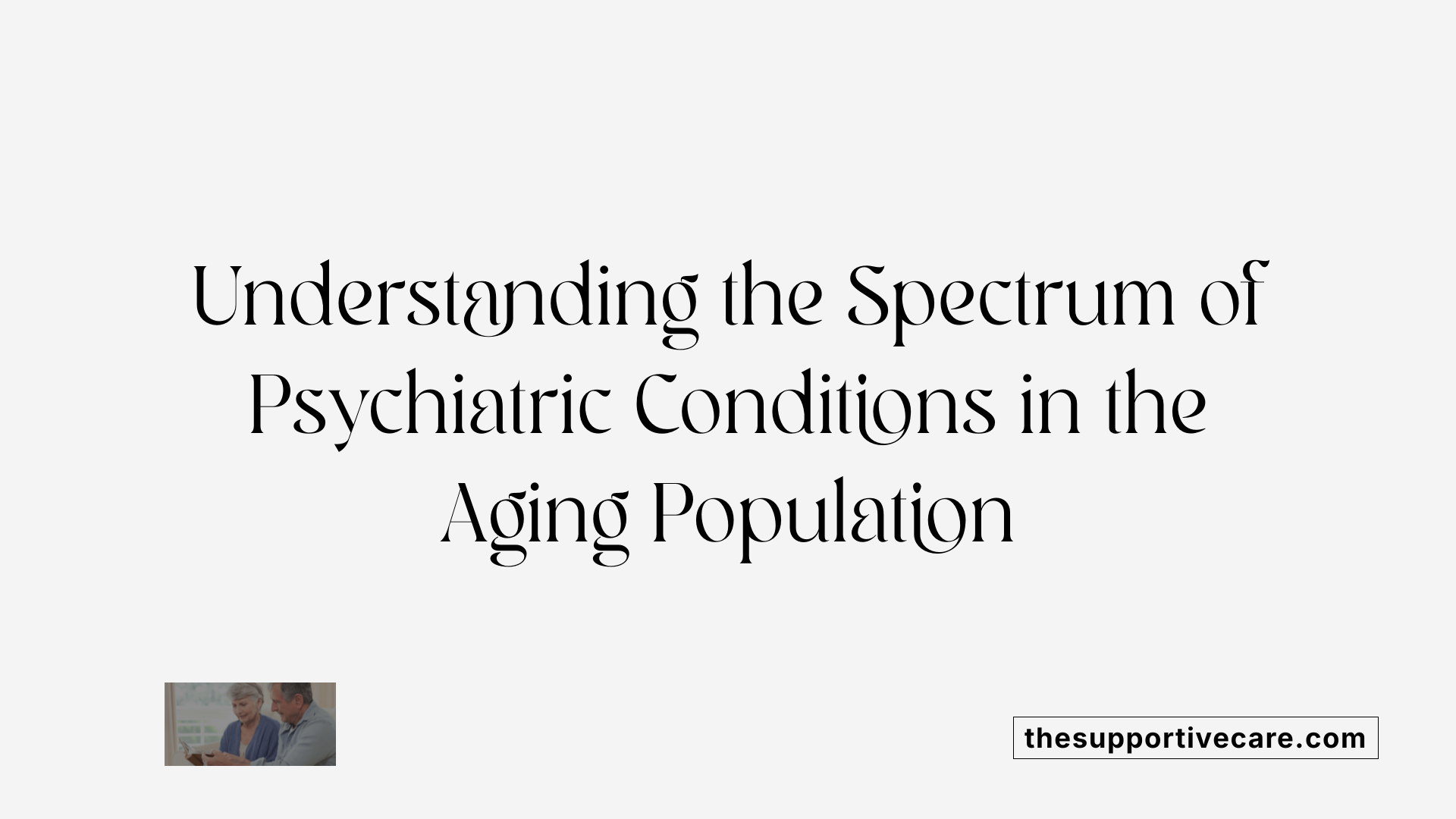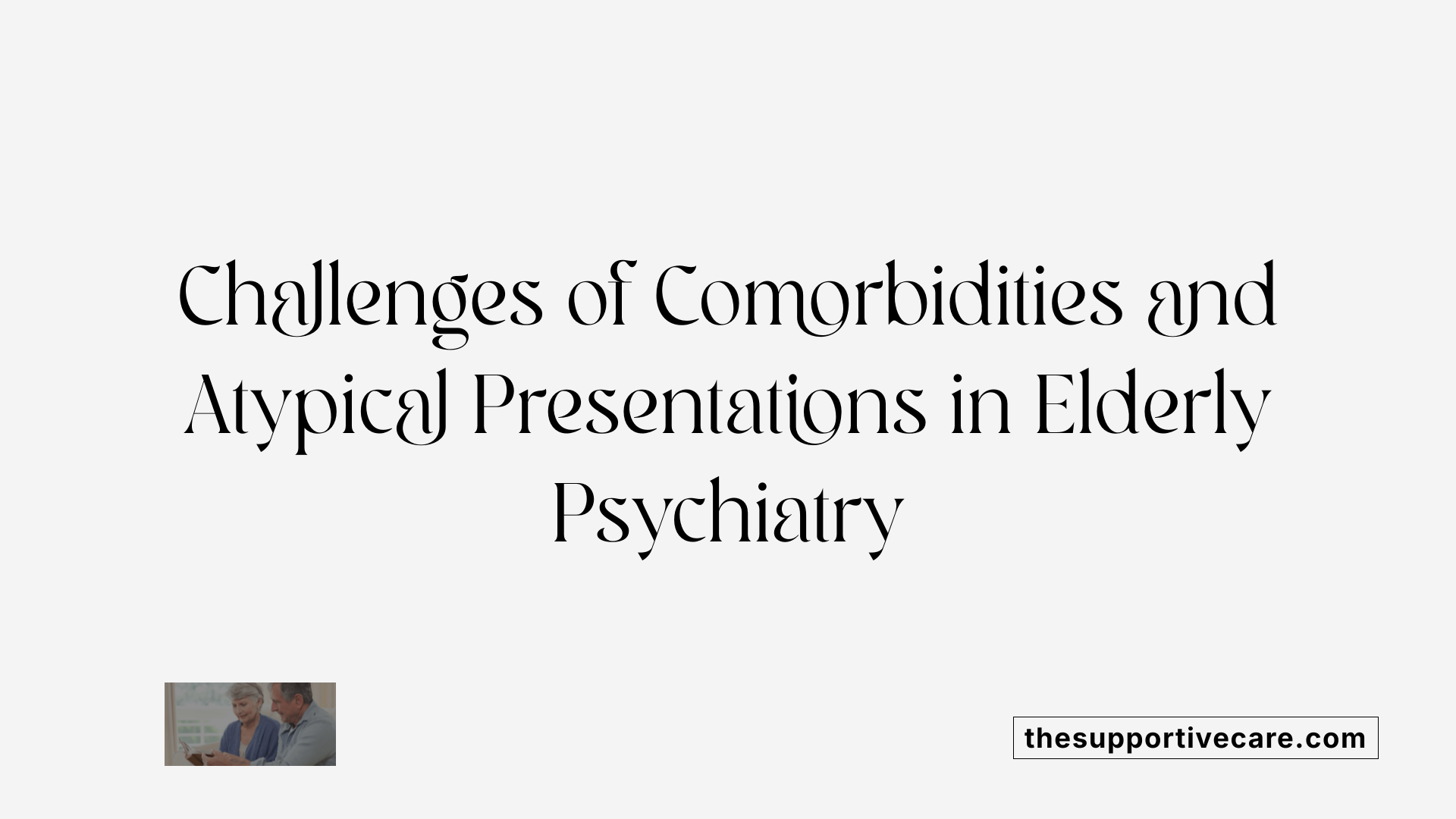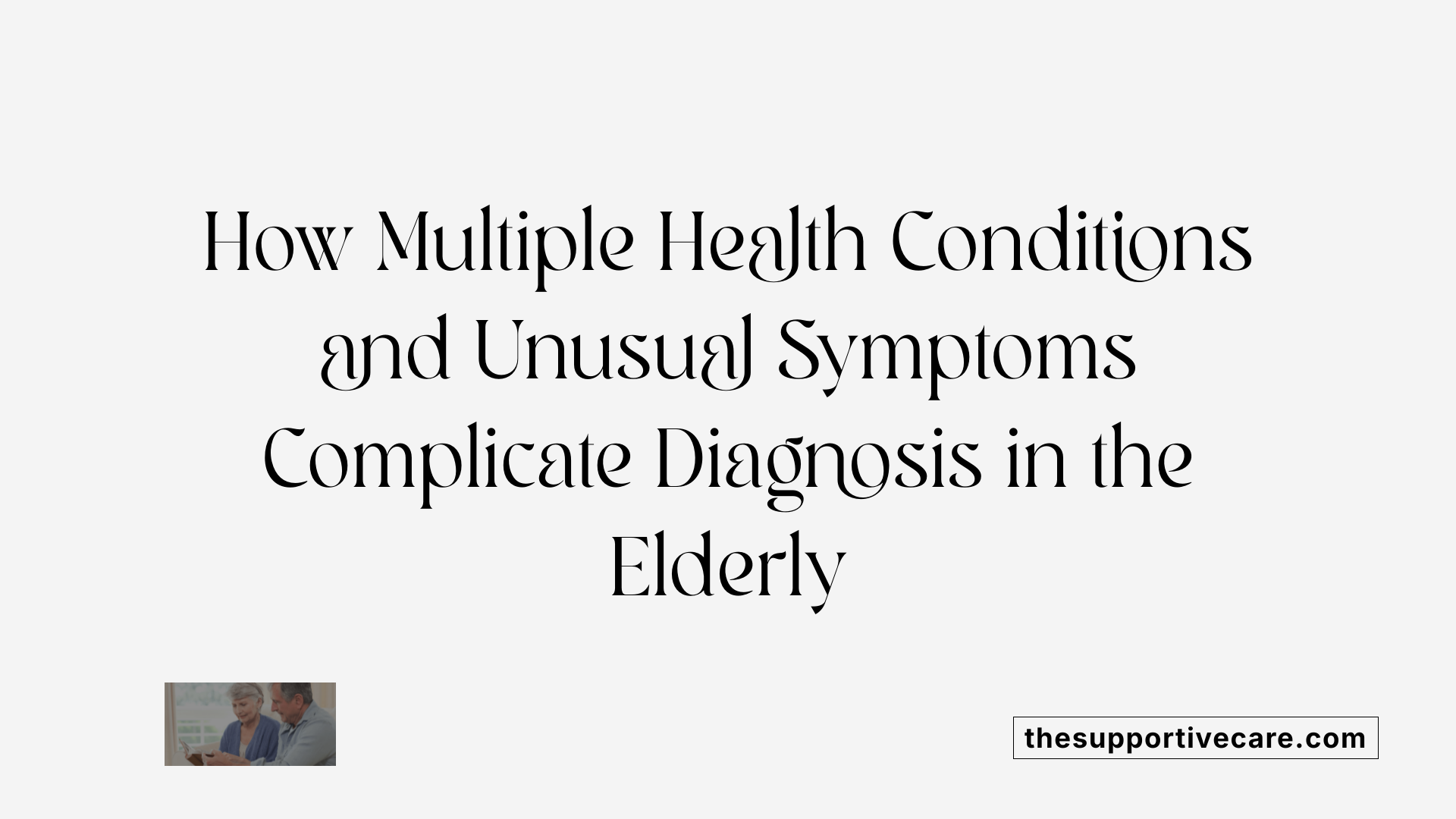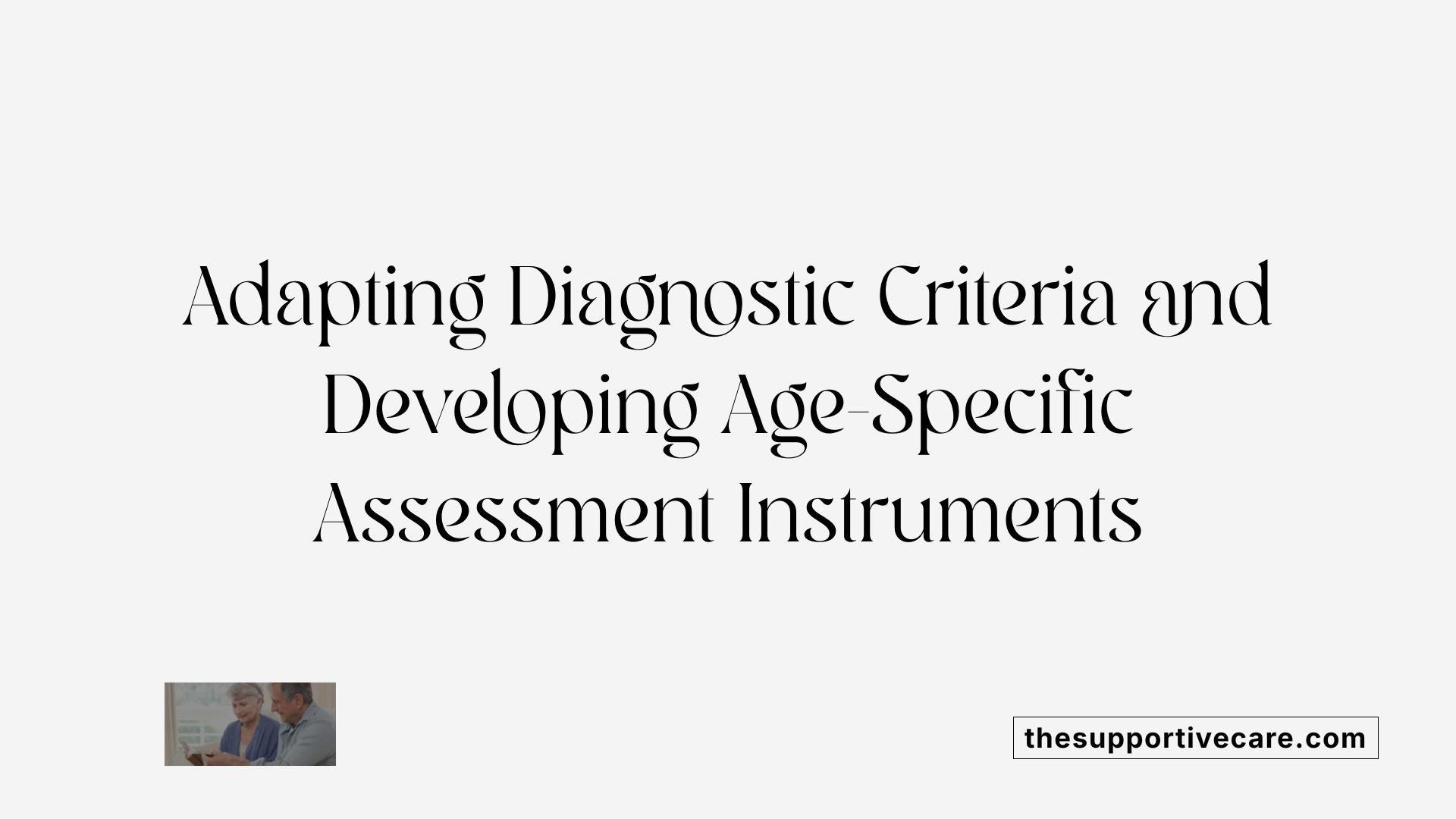Understanding the Diagnostic Challenges in Older Adults
Accurate diagnosis of psychiatric illnesses in geriatric patients is fraught with unique challenges stemming from biological, psychological, and social factors. As the population ages, healthcare professionals face increasing difficulty in distinguishing mental health conditions amid a backdrop of comorbid physical diseases, atypical presentations, and age-related changes. This article explores the multifaceted obstacles in diagnosing psychiatric disorders within the elderly, emphasizing the need for tailored approaches and improved assessment tools.
Main Challenges in Diagnosing Psychiatric Illnesses in the Elderly
 Diagnosing psychiatric illnesses in older adults involves navigating several complex issues. One of the primary challenges is the high prevalence of co-morbid medical and neurological conditions. These often obscure or mimic psychiatric symptoms, making it difficult to distinguish mental health disorders from physical illnesses. For instance, conditions such as Parkinson’s disease or vascular dementia can present with mood swings, confusion, or behavioral changes typical of psychiatric conditions.
Diagnosing psychiatric illnesses in older adults involves navigating several complex issues. One of the primary challenges is the high prevalence of co-morbid medical and neurological conditions. These often obscure or mimic psychiatric symptoms, making it difficult to distinguish mental health disorders from physical illnesses. For instance, conditions such as Parkinson’s disease or vascular dementia can present with mood swings, confusion, or behavioral changes typical of psychiatric conditions.
Age-related physiological and cognitive changes further complicate diagnosis. Older patients frequently exhibit atypical symptom presentations — depression may manifest as fatigue or bodily aches, rather than sadness, while anxiety can appear as physical symptoms like chest pains or trembling. This can lead to underrecognition or misdiagnosis.
Existing diagnostic criteria like DSM or ICD were primarily developed based on younger populations and may not fully capture the subtle or different presentations in elderly patients. Standard assessment tools often rely on interviews and observation, which can be limited by the patient's cognitive status or communication difficulties.
Social factors, including stigma, loneliness, and social isolation, influence diagnosis as well. Older adults may be less likely to report mental health concerns due to stigma or beliefs that such issues are a normal part of aging. Additionally, clinicians' biases or misconceptions can delay recognition — for example, attributing symptoms solely to aging or physical health issues.
Addressing these challenges requires a comprehensive approach, combining thorough medical evaluation, neuropsychological testing, and social assessment. Educating healthcare providers about age-specific symptom expression and promoting awareness can improve detection and treatment, enhancing mental health care for the elderly.
Common Psychiatric Disorders in Older Adults

What are the common psychiatric disorders in older adults?
Older adults commonly face a range of mental health conditions that often overlap with physical health problems, making diagnosis and management challenging. The most prevalent psychiatric issues include depression, anxiety, dementia—including Alzheimer’s disease and Lewy body dementia—delirium, and psychosis associated with neurological conditions such as Parkinson’s disease and cerebrovascular disorders.
Depression affects about 10-20% of seniors, but it is frequently underdiagnosed because symptoms may present atypically, such as with somatic complaints rather than overt sadness. Anxiety disorders, affecting roughly 3-14% of older adults, often manifest with excessive nervousness, physical symptoms like trembling, and avoidance behaviors.
Dementia involves progressive cognitive decline, memory loss, and behavioral disturbances. Alzheimer’s disease is the most common type, but neurodegenerative disorders like Lewy body dementia also contribute to the cognitive decline seen in aging populations.
Delirium, characterized by acute confusion and disorientation, is often caused by infections, medication side effects, or trauma. It tends to be transient but is frequently underdiagnosed, with only a small fraction identified during hospitalization.
Psychosis, including hallucinations and delusions, frequently appears in older adults with underlying neurological conditions or severe mental health disorders. For example, Parkinson’s disease can bring about Parkinsonian psychosis.
Behavioral and psychological symptoms of dementia—collectively known as BPSD—such as agitation, aggression, sleep disturbances, and mood swings, are common and can significantly impact quality of life and caregiving.
Overall, these psychiatric conditions often interact with physical health issues, which can obscure or mimic mental health symptoms, complicating diagnosis. Recognizing these disorders early and distinguishing between psychiatric and medical causes are essential for providing appropriate care.
| Disorder | Prevalence Estimate | Typical Features | Related Conditions |
|---|---|---|---|
| Depression | 10-20% | Low mood, anhedonia, fatigue, somatic complaints | Chronic illness, bereavement, social isolation |
| Anxiety | 3-14% | Excessive worry, physical symptoms, social avoidance | Chronic medical illness |
| Dementia (Alzheimer’s) | Increasing with age | Memory loss, confusion, behavioral changes | Neurodegenerative diseases |
| Delirium | Underdiagnosed, common in hospitals | Sudden confusion, disorientation | Medications, infections, trauma |
| Psychosis | Common in neurological diseases | Hallucinations, delusions | Parkinson’s, stroke, dementia |
Awareness of these prevalent conditions and their intricate links with physical health is crucial for timely diagnosis and effective management in older adults.
Factors Making Diagnosis More Difficult in Older Adults
 Diagnosing mental health conditions in older adults is a complex task that involves multiple overlapping factors. One of the main challenges stems from the overlap of symptoms with normal aging and physical illnesses. As individuals age, they often experience changes like memory lapses, slowed processing, and mood fluctuations, which can be mistaken for psychiatric symptoms. Furthermore, many geriatric patients also contend with chronic medical conditions such as heart disease, diabetes, or arthritis. These comorbidities can mask or mimic psychiatric symptoms, making it difficult to determine whether a symptom stems from a mental health disorder or a physical illness.
Diagnosing mental health conditions in older adults is a complex task that involves multiple overlapping factors. One of the main challenges stems from the overlap of symptoms with normal aging and physical illnesses. As individuals age, they often experience changes like memory lapses, slowed processing, and mood fluctuations, which can be mistaken for psychiatric symptoms. Furthermore, many geriatric patients also contend with chronic medical conditions such as heart disease, diabetes, or arthritis. These comorbidities can mask or mimic psychiatric symptoms, making it difficult to determine whether a symptom stems from a mental health disorder or a physical illness.
Cognitive decline adds another layer of difficulty. Conditions like dementia and delirium present with symptoms such as confusion, disorientation, and behavioral changes that may be misattributed to aging or overlooked. Standard assessment tools developed for younger populations may not be validated for use in elderly patients, leading to ambiguous or inaccurate results.
Beyond biological factors, social and psychological elements also play a role. Ageist stereotypes and stigma can hinder both the diagnosis and treatment of mental health issues among older adults. Clinicians might underestimate the prevalence of psychiatric conditions in this age group or dismiss symptoms as normal aging, resulting in underdiagnosis. Moreover, older adults themselves may be reluctant to seek help due to fear, shame, or fear of being labeled as mentally unwell.
Social isolation, loneliness, bereavement, and abuse are additional risk factors that influence mental health but may also complicate diagnosis. These factors can intensify symptoms or create new behavioral problems, which might not be easily linked to a specific psychiatric disorder.
Finally, the limited validation of assessment tools specifically for the elderly population means clinicians often lack reliable instruments tailored to their unique presentation. Overall, the intersection of biological, social, and systemic factors makes accurate diagnosis in older adults particularly challenging, emphasizing the need for specialized, holistic assessment strategies.
For further insights into these diagnostic difficulties, searching terms like "diagnostic difficulties in elderly psychiatry" can provide additional resources and updates.
Impact of Comorbidities and Atypical Presentations on Diagnosis

How do comorbidities and atypical presentations affect diagnosis in the elderly?
Diagnosing psychiatric disorders in older adults is often complicated by the presence of multiple physical health conditions, known as comorbidities. Conditions such as heart disease, diabetes, neurodegenerative diseases (like dementia and Parkinson's), and vascular issues frequently coexist with mental health problems.
These comorbidities can mask or mimic psychiatric symptoms, making it difficult for clinicians to distinguish between physical and mental health issues. For example, depression may present primarily with somatic complaints such as fatigue, weight changes, or sleep disturbances, rather than the classic emotional symptoms, leading to misdiagnosis or underdiagnosis.
Polypharmacy, common among seniors—who often take an average of 6-8 medications—raises the risk of drug interactions and side effects that can alter mental state. Medications intended for physical ailments may induce cognitive impairment or mood changes, which further complicate accurate diagnosis.
Additionally, age-related physiological changes, such as reduced processing speed, sensory decline, and altered metabolism, influence how symptoms manifest. Cognitive decline may be subtle or overlap with early stages of dementia, making clinical evaluation more complex.
Atypical presentations, like agitation, confusion, or unexplained physical symptoms, are common and can be mistaken for primary medical issues. This diversity in symptom expression underscores the necessity for comprehensive, multidisciplinary assessments involving medical history, neuropsychological testing, and neuroimaging.
In conclusion, the interplay of multiple health conditions, medication effects, and age-related changes warrants an integrated diagnostic approach, emphasizing careful history-taking, collateral information, and advanced assessment tools to accurately identify psychiatric disorders in the elderly.
Need for Diagnostic Modifications and Specialized Assessment Tools
 Diagnosing psychiatric disorders in older adults presents unique challenges, highlighting the need for adapted diagnostic criteria and assessment strategies. Standard tools like the DSM-5, while comprehensive for general populations, often fall short in capturing the nuanced and atypical symptoms that occur in aging individuals. To improve diagnostic accuracy, clinicians have started modifying existing criteria, especially for neurocognitive disorders, incorporating biomarkers such as CSF testing, PET scans, and neuroimaging findings that can support clinical judgments.
Diagnosing psychiatric disorders in older adults presents unique challenges, highlighting the need for adapted diagnostic criteria and assessment strategies. Standard tools like the DSM-5, while comprehensive for general populations, often fall short in capturing the nuanced and atypical symptoms that occur in aging individuals. To improve diagnostic accuracy, clinicians have started modifying existing criteria, especially for neurocognitive disorders, incorporating biomarkers such as CSF testing, PET scans, and neuroimaging findings that can support clinical judgments.
Development of age-specific assessment instruments has become essential. Neuropsychological testing now covers multiple cognitive domains, including memory, processing speed, attention, language, visuospatial skills, and executive function, to detect subtle changes that may indicate early pathology. These tools help differentiate between normal age-related cognitive decline and early signs of dementia or other neurodegenerative diseases.
Furthermore, addressing atypical and subtle presentations involves integrating comprehensive evaluations that go beyond symptom checklists. Functional assessments, collateral histories from family or caregivers, and consideration of comorbid physical health conditions are vital. Because symptoms such as confusion, mood changes, or behavioral disturbances may mimic or mask medical illnesses, a multidimensional approach is crucial.
Overall, modifications in diagnostic criteria and the development of tailored assessment methods are vital for early detection, accurate diagnosis, and effective management of psychiatric and neurodegenerative disorders in the elderly. These adaptations aim to reduce misdiagnosis, improve treatment outcomes, and meet the specific needs of older adults.
Factors Affecting Diagnostic Accuracy and Research Challenges
What factors influence the accuracy of psychiatric diagnosis in the elderly?
Diagnosing psychiatric disorders in older adults presents unique challenges due to various influencing factors. Symptom similarity among different mental health conditions, such as depression, anxiety, and early cognitive decline, can lead to misclassification or delayed diagnosis.
Many psychiatric symptoms overlap with physical health issues common in aging, like chronic illnesses or medication side effects, complicating clinical judgment. For example, fatigue or confusion might be attributed to medical conditions rather than a mood disorder.
Assessment tools and diagnostic criteria, often based on younger populations, may not be fully validated for older adults, limiting their reliability and sensitivity. Observational assessments and clinical interviews heavily rely on collateral information from family members or caregivers, which may be incomplete or biased.
Clinicians’ biases and limited training in geriatric psychiatry can also impact accuracy. Nonpsychiatric healthcare providers may overlook psychiatric symptoms, especially if the presentation is atypical.
Research gaps and systemic issues further hinder progress. There is a shortage of specialized geriatric mental health professionals, and existing tools lack widespread validation tailored for the elderly.
Addressing these challenges involves developing age-specific diagnostic criteria, enhancing clinician education, employing comprehensive evaluations with input from multiple sources, and utilizing standardized, validated assessment instruments suitable for older populations.
| Factor | Impact | Additional Note |
|---|---|---|
| Symptom overlap | Risk of misdiagnosis | Similar symptoms can belong to different disorders or physical illnesses |
| Limited tools | Diagnostic uncertainty | Tools not specifically validated for older adults |
| Collateral info | Variability and bias | Reports depend on caregivers’ accuracy |
| Clinician biases | Underdiagnosis or misclassification | Insufficient training in geriatric psychiatry |
| Research gaps | Slower progress | Lack of comprehensive, validated assessments for elderly |
Continuing improvements in diagnostic practices and tailored tools are essential for better mental health outcomes in the aging population.
Improving Diagnosis and Care in Geriatric Mental Health
Addressing the diagnostic challenges in geriatric psychiatry requires a multifaceted approach that includes refining assessment tools, training healthcare providers, and developing age-specific criteria. Enhancing clinician awareness of atypical presentations and the influence of comorbidities will lead to earlier detection and better management of mental health issues. Moreover, increasing research dedicated to aging populations, reducing systemic barriers, and promoting interdisciplinary collaboration are vital steps to improve diagnostic accuracy and healthcare outcomes. As the demographic shift toward an older population continues, these efforts are indispensable to ensure that psychiatric care for the elderly is both effective and equitable.
References
- Psychological Problem Diagnosis and Management in the Geriatric ...
- Diagnostic challenges in the older patient - PMC - PubMed Central
- Psychiatric Assessment and Diagnosis in Older Adults | Focus
- Diagnostic Problems in Geriatric Psychiatry - SpringerLink
- Difficulties Diagnosing Geriatric Bipolar Disorder - Psychiatric Times
- The Difficult Task of Diagnosing Depression in Elderly People with ...
- 5 Mental Health Diagnostic Challenges: Update on “To Err Is Human”
- FREQUENTLY MISSED DIAGNOSIS IN GERIATRIC PSYCHIATRY



































































































